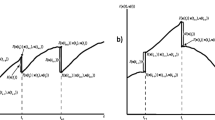Abstract
In this paper, a stochastic control model is constructed by incorporating geometric Brownian motion to capture uncertain price dynamics into a one-stage and two-state stochastic dynamic programming model. The proposed model is designed to search for optimal harvest timing under price uncertainty without considering other forestry operations,e.g., thinning. We consider the option of abandoning forest management for an alternative use of forest land besides replantation. Our experimental analysis shows that the optimal harvest timing under stochastic log prices is delayed when a price level is crucially low for maintaining the management. It is also shown that when the current log price is sufficiently high, the optimal harvest timing derived from both the stochastic and deterministic approach becomes the same. With a downward trend of stochastic price dynamics, the optimal harvest timing tends to be hastened overall. This is because of the depreciation effect on the future return, which stimulates harvesting in an earlier period.
Similar content being viewed by others
Literature cited
Akaike, H. (1977) On entropy maximization principle.In Application of statistics. Krishnaiah, P.R. (ed.), 543pp., North-Holland, Amsterdam, 27–41.
Bailey, W. (1991) Valuing agricultural firms: An examination of the contingent-claims approach to pricing real assets. J. Econ. Dynam. Cont. 15: 771–791.
Brennan, M.J. and Schwartz, E.S. (1985) Evaluating natural resource investments. J. Bus. 58: 135–157.
Clarke, H.R. and Reed, W.J. (1989) The tree-cutting problem in a stochastic environment. J. Econ. Dynam. Cont. 13: 569–595.
Cox, J.C., Ross, S.A., and Rubinstein, M. (1979) Option pricing: A simplified approach. J. Financ. Econ. 7: 229–263.
Faustmann, M. (1849) On the determination of the value which forest land and immature stands possess for forestry. Reprinted in J. For. Econ. 1: 7–44 (1995).
Haight, R.G. and Holmes, T.P. (1991) Stochastic price models and optimal tree cutting results for loblolly pine. Nat. Resour. Model. 5: 423–443.
Hillier, F.S. and Lieberman, G.J. (1990) Introduction to operations research. 954pp, McGraw Hill, New York.
Gardiner, C.W. (1985) Handbook of stochastic methods. 442pp, Springer, New York.
Morck, R., Schwartz, E., and Stangeland, D. (1989) The valuation of forestry resources under stochastic prices and investments. J. Financ. Quant. Anal. 24: 473–487.
Øksendal, B. (1995) Stochastic differential equations. 271pp, Springer, New York.
Plantinga, A.J. (1998) The optimal timber rotation: An option value approach. Forest Sci. 44: 192–202.
Reed, W.J. and Clarke, H.R. (1990) Harvest decisions and asset valuations for biological resources exhibiting size-dependent growth. Int. Econ. Rev. 31: 147–169.
Reed, W.J. and Ye, J.J. (1994) The role of stochastic monotonicity in the decision to conserve or harvest old-growth forest. Nat. Resour. Model. 8: 47–79.
Richards, F.J. (1958) A flexible growth function to empirical use. J. Exp. Bot. 10: 290–300.
Ross, S.M. (1983) Introduction to stochastic dynamic programming. 164pp, Academic Press, New York.
Ross, S.M. (1993) Introduction to probability models. 556pp, Academic Press, New York.
Samuelson, P.A. (1976) Economics of forestry in an evolving society. Econ. Inq. 14: 466–492.
Thomson, T.A. (1992) Optimal forest rotation when stumpage prices follow a diffusion process. Land Econ. 68: 329–342.
Thorsen, B.J. (1999) Afforestration as a real option: Some policy implications. Forest Sci. 45(2): 171–178
Yoshimoto, A. and Shoji, I. (1998) Searching for an optimal rotation age for forest stand management under stochastic log prices. Eur. J. Oper. Res. 105: 100–112.
Yukutake, K. and Yoshimoto, A. (2001) Cost analysis of timber production from domestic resurces. Jpn. J. For. Plann. 35: 75–80.
Zinkhan, F.C. (1991) Option pricing and timberland’s land-use conversion option. Land Econ. 67: 317–325.
Author information
Authors and Affiliations
Corresponding author
Additional information
This research was supported by a Grant-in-Aid for Scientific Research (No.11660155) from the Ministry of Education, Culture, Sports, Science and Technology of Japan.
About this article
Cite this article
Yoshimoto, A. Stochastic control modeling for forest stand management under uncertain price dynamics through geometric brownian motion. J For Res 7, 81–90 (2002). https://doi.org/10.1007/BF02762512
Received:
Accepted:
Issue Date:
DOI: https://doi.org/10.1007/BF02762512




